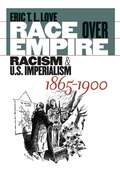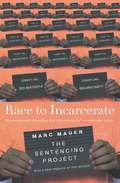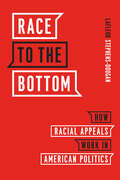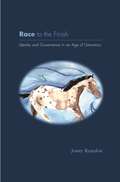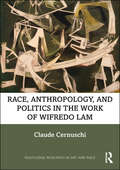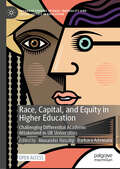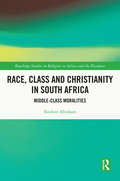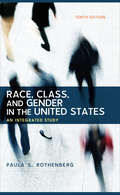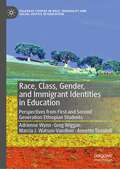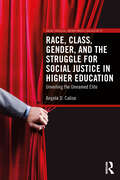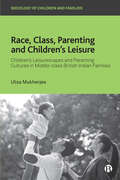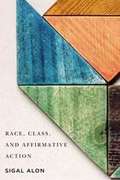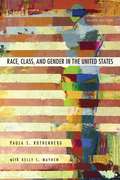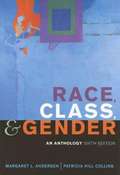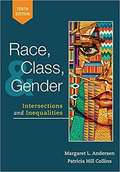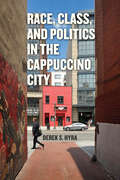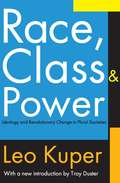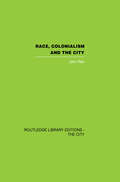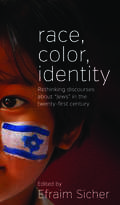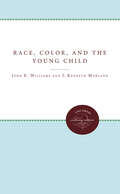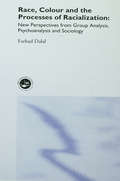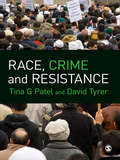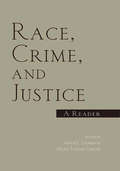- Table View
- List View
Race over Empire
by Eric T. LoveGenerations of historians have maintained that in the last decade of the nineteenth century white-supremacist racial ideologies such as Anglo-Saxonism, social Darwinism, benevolent assimilation, and the concept of the "white man's burden" drove American imperialist ventures in the nonwhite world. In Race over Empire, Eric T. L. Love contests this view and argues that racism had nearly the opposite effect. From President Grant's attempt to acquire the Dominican Republic in 1870 to the annexations of Hawaii and the Philippines in 1898, Love demonstrates that the imperialists' relationship with the racist ideologies of the era was antagonistic, not harmonious. In a period marked by Jim Crow, lynching, Chinese exclusion, and immigration restriction, Love argues, no pragmatic politician wanted to place nonwhites at the center of an already controversial project by invoking the concept of the "white man's burden." Furthermore, convictions that defined "whiteness" raised great obstacles to imperialist ambitions, particularly when expansionists entered the tropical zone. In lands thought to be too hot for "white blood," white Americans could never be the main beneficiaries of empire.What emerges from Love's analysis is a critical reinterpretation of the complex interactions between politics, race, labor, immigration, and foreign relations at the dawn of the American century.
Race to Incarcerate
by Marc MauerIn this revised edition of his seminal book on race, class, and the criminal justice system, Marc Mauer, executive director of one of the United States' leading criminal justice reform organizations, offers the most up-to-date look available at three decades of prison expansion in America.Including newly written material on recent developments under the Bush administration and updated statistics, graphs, and charts throughout, the book tells the tragic story of runaway growth in the number of prisons and jails and the overreliance on imprisonment to stem problems of economic and social development. Called "sober and nuanced" by Publishers Weekly, Race to Incarcerate documents the enormous financial and human toll of the "get tough" movement, and argues for more humane-and productive-alternatives.
Race to the Bottom: How Racial Appeals Work in American Politics (Chicago Studies in American Politics)
by LaFleur Stephens-DouganAfrican American voters are a key demographic to the modern Democratic base, and conventional wisdom has it that there is political cost to racialized “dog whistles,” especially for Democratic candidates. However, politicians from both parties and from all racial backgrounds continually appeal to negative racial attitudes for political gain. Challenging what we think we know about race and politics, LaFleur Stephens-Dougan argues that candidates across the racial and political spectrum engage in “racial distancing,” or using negative racial appeals to communicate to racially moderate and conservative whites—the overwhelming majority of whites—that they will not disrupt the racial status quo. Race to the Bottom closely examines empirical data on racialized partisan stereotypes to show that engaging in racial distancing through political platforms that do not address the needs of nonwhite communities and charged rhetoric that targets African Americans, immigrants, and others can be politically advantageous. Racialized communication persists as a well-worn campaign strategy because it has real electoral value for both white and black politicians seeking to broaden their coalitions. Stephens-Dougan reveals that claims of racial progress have been overstated as our politicians are incentivized to employ racial prejudices at the expense of the most marginalized in our society.
Race to the Finish: Identity and Governance in an Age of Genomics (In-Formation)
by Jenny ReardonIn the summer of 1991, population geneticists and evolutionary biologists proposed to archive human genetic diversity by collecting the genomes of "isolated indigenous populations." Their initiative, which became known as the Human Genome Diversity Project, generated early enthusiasm from those who believed it would enable huge advances in our understanding of human evolution. However, vocal criticism soon emerged. Physical anthropologists accused Project organizers of reimporting racist categories into science. Indigenous-rights leaders saw a "Vampire Project" that sought the blood of indigenous people but not their well-being. More than a decade later, the effort is barely off the ground. How did an initiative whose leaders included some of biology's most respected, socially conscious scientists become so stigmatized? How did these model citizen-scientists come to be viewed as potential racists, even vampires? This book argues that the long abeyance of the Diversity Project points to larger, fundamental questions about how to understand knowledge, democracy, and racism in an age when expert claims about genomes increasingly shape the possibilities for being human. Jenny Reardon demonstrates that far from being innocent tools for fighting racism, scientific ideas and practices embed consequential social and political decisions about who can define race, racism, and democracy, and for what ends. She calls for the adoption of novel conceptual tools that do not oppose science and power, truth and racist ideologies, but rather draw into focus their mutual constitution.
Race under Reconstruction in German Cinema
by Angelica FennerRace Under Reconstruction in German Cinema investigates postwar racial formations via a pivotal West German film by one of the most popular and prolific directors of the era. The release of Robert Stemmle's Toxi (1952) coincided with the enrolment in West German schools of the first five hundred Afro-German children fathered by African-American occupation soldiers. The didactic plot traces the ideological conflicts that arise among members of a patrician family when they encounter an Afro-German child seeking adoption, herein broaching issues of integration at a time when the American civil rights movement was gaining momentum and encountering violent resistance.Perceptions of 'Blackness' in Toxi demonstrate continuities with those prevailing in Wilhelmine Germany, but also signal the influence of American social science discourse and tropes originating in icons of American popular culture, such as Uncle Tom's Cabin, Birth of a Nation, and several Shirley Temple films. By applying a Cultural Studies approach to individual film sequences, publicity photos, and press reviews, Angelica Fenner relates West German discourses around race and integration to emerging economic and political anxieties, class antagonism, and the reinstatement of conventional gender roles.The film Toxi is now available on DVD from the DEFA Film Library.
Race, Anthropology, and Politics in the Work of Wifredo Lam (Routledge Research in Art and Race)
by Claude CernuschiThis book reinterprets Wifredo Lam’s work with particular attention to its political implications, focusing on how these implications emerge from the artist’s critical engagement with 20th-century anthropology. Field work conducted in Cuba, including the witnessing of actual Afro-Cuban religious ritual ceremonies and information collected from informants, enhances the interpretive background against which we can construe the meanings of Lam's art. In the process, Claude Cernuschi argues that Lam hoped to fashion a new hybrid style to foster pride and dignity in the Afro-Cuban community, as well as counteract the acute racism of Cuban culture.
Race, Capital, and Equity in Higher Education: Challenging Differential Academic Attainment in UK Universities (Palgrave Studies in Race, Inequality and Social Justice in Education)
by Alexander Hensby Barbara AdewumiThis book examines the structural and cultural factors that explain the persistence of an attainment gap between white and Black, Asian, and Minority Ethnic (BAME) students in UK universities. So-called ‘deficit’ approaches have long represented the orthodoxy in higher education strategy-making, yet they overlook the structural and institutional factors that reproduce attainment gaps. Whereas students already in possession of the right ‘academic capital’ are made to feel validated and empowered in their learning, BAME students – particularly those from working class backgrounds – may feel marginalised by dominant hierarchical cultures on campus.This book provides an important and unique contribution to the study of racial equity in higher education. Its chapters provide a breadth and depth of analyses which help explain the roots of the attainment gap, while offering reflections and commentaries on the necessary steps that universities must take in order to ensure equityfor students from all backgrounds.
Race, Class and Christianity in South Africa: Middle-Class Moralities (Routledge Studies on Religion in Africa and the Diaspora)
by Ibrahim AbrahamThis book explores the relationship between race and class among middle-class Christians in South Africa. The book provides a theoretically sophisticated and empirically rich study of middle-class Christians in contemporary South Africa, as they seek to live good lives and build a good society. Focused on the city of Cape Town, drawing upon ethnographic research in conservative and progressive multiracial Protestant churches, furnished with critical analysis of South African literature and popular culture, this timely study explores expressions of ambition and anxiety that are both spiritual and material. Building upon debates over middle-class identity and morality from sociology, anthropology, and cultural studies, this book analyses congregational attempts at social unity through worship music and creative youth ministry, discussions on white privilege and shame, and the impact of middle-class black activism in South African churches and society. This book will be of interest to researchers of South African culture and society, religion, anthropology, and sociology.
Race, Class, And Gender In The United States 10th Edition
by Paula S. Rothenberg Soniya MunshiThis best-selling anthology expertly explores concepts of identity, diversity and inequality as it introduces students to race, class, gender, and sexuality in the United States. The thoroughly updated 10th edition features 38 new readings. New material explores citizenship and immigration, mass incarceration, sex crimes on campus, transgender identity, the school to prison pipeline, food insecurity, the Black Lives Matter movement, the pathology of poverty, socioeconomic privilege vs. racial privilege, pollution on tribal lands, stereotype threat, gentrification and more. The combination of thoughtfully selected readings, deftly written introductions, and careful organization make Race, Class, and Gender, 10th edition the most engaging and balanced presentation of these issues available today.
Race, Class, Gender, and Immigrant Identities in Education: Perspectives from First and Second Generation Ethiopian Students (Palgrave Studies in Race, Inequality and Social Justice in Education)
by Greg Wiggan Marcia J. Watson-Vandiver Adrienne Wynn Annette TeasdellThis volume addresses the underlying intersections of race, class, and gender on immigrant girls’ experiences living in the US. It examines the impact of acculturation and assimilation on Ethiopian girls’ academic achievement, self-identity, and perception of beauty. The authors employ Critical Race Theory, Critical Race Feminism, and Afrocentricity to situate the study and unpack the narratives shared by these newcomers as they navigate social contexts rife with racism, xenophobia, and other forms of oppression. Lastly, the authors examine the implications of Ethiopian immigrant identities and experiences within multicultural education, policy development, and society.
Race, Class, Gender, and the Struggle for Social Justice in Higher Education: Unveiling the Unnamed Elite (New Critical Viewpoints on Society)
by Angela D. CaliseOffering readers an insightful exploration of the challenges faced by leaders in higher education as they navigate the complexities of promoting social justice and caring for minoritized populations, this book delves into their untold stories to reveal the triumphs and struggles of these influential individuals.By unveiling the undercurrents of higher education and the hidden dynamics at play, Race, Class, Gender, and the Struggle for Social Justice in Higher Education details the battle for social justice and the experiences of leadership elites, serving as an invaluable resource for anyone passionate about the intersection of leadership, social justice, and the imperative to create inclusive environments in higher education, shedding light on leaders’ motivations, behaviors, and barriers in advancing social justice on college campuses.This book will be relevant to instructors and students in higher education, leadership, and sociology courses, offering insights into the challenges faced by leadership elites in promoting social justice and supporting marginalized populations.
Race, Class, Parenting and Children’s Leisure: Children’s Leisurescapes and Parenting Cultures in Middle-class British Indian Families (Sociology of Children and Families)
by Utsa MukherjeeChildren’s leisure lives are changing, with increasing dominance of organised activities and screen-based leisure. These shifts have reconfigured parenting practices, too. However, our current understandings of these processes are race-blind and based mostly on the experiences of white middle-class families. Drawing on an innovative study of middle-class British Indian families, this book brings children’s and parents’ voices to the forefront and bridges childhood studies, family studies and leisure studies to theorise children’s leisure from a fresh perspective. Demonstrating the salience of both race and class in shaping leisure cultures within middle-class racialised families, this is an invaluable contribution to key sociological debates around leisure, childhoods and parenting ideologies.
Race, Class, and Affirmative Action
by Sigal AlonNo issue in American higher education is more contentious than that of race-based affirmative action. In light of the ongoing debate around the topic and recent Supreme Court rulings, affirmative action policy may be facing further changes. As an alternative to race-based affirmative action, some analysts suggest affirmative action policies based on class. In Race, Class, and Affirmative Action, sociologist Sigal Alon studies the race-based affirmative action policies in the United States. and the class-based affirmative action policies in Israel. Alon evaluates how these different policies foster campus diversity and socioeconomic mobility by comparing the Israeli policy with a simulated model of race-based affirmative action and the U.S. policy with a simulated model of class-based affirmative action. Alon finds that affirmative action at elite institutions in both countries is a key vehicle of mobility for disenfranchised students, whether they are racial and ethnic minorities or socioeconomically disadvantaged. Affirmative action improves their academic success and graduation rates and leads to better labor market outcomes. The beneficiaries of affirmative action in both countries thrive at elite colleges and in selective fields of study. As Alon demonstrates, they would not be better off attending less selective colleges instead. Alon finds that Israel’s class-based affirmative action programs have provided much-needed entry slots at the elite universities to students from the geographic periphery, from high-poverty high schools, and from poor families. However, this approach has not generated as much ethnic diversity as a race-based policy would. By contrast, affirmative action policies in the United States have fostered racial and ethnic diversity at a level that cannot be matched with class-based policies. Yet, class-based policies would do a better job at boosting the socioeconomic diversity at these bastions of privilege. The findings from both countries suggest that neither race-based nor class-based models by themselves can generate broad diversity. According to Alon, the best route for promoting both racial and socioeconomic diversity is to embed the consideration of race within class-based affirmative action. Such a hybrid model would maximize the mobility benefits for both socioeconomically disadvantaged and minority students. Race, Class, and Affirmative Action moves past political talking points to offer an innovative, evidence-based perspective on the merits and feasibility of different designs of affirmative action.
Race, Class, and Gender in the United States: An Integrated Study
by Paula S. RothenbergThis book presents an integrated study into a better world, a community that identifies, tackles and solves its problems effectively. Thinking about the community and its characteristics, it focuses on race, gender and sexuality from a social context. As much as the titles sound like happenings of the past, way back from our forefathers of our forefathers, its what makes up and differentiates communities from each other. Surprisingly, every community has norms and behaviors, beliefs and gender roles that govern them yet to others may be held as discrimination against the specified gender. Race, Class, And Gender In The United States,inclusively takes an in-depth study in racism, sexism, heterosexism, and class, and Complicating Questions of Identity: Race, Ethnicity and Immigration.
Race, Class, and Gender: An Anthology
by Patricia Hill Collins Margaret L. AndersenEach reading addresses a timely-and often controversial-topic, such as health care inequality, undocumented students, domestic violence, genetic technologies, and the effect of the media on body image, thereby giving readers a multidimensional perspective on a number of social issues.
Race, Class, and Gender: An Anthology (6th edition)
by Patricia Hill Collins Margaret L. AndersenThis anthology introduces students to how race, class, and gender shape the experiences of diverse groups in the U.S. Introductory essays for each of the four sections stress the interconnectedness of these various types of difference. Each section concludes with some suggestions for further reading. The sixth edition contains 19 new readings dealing with such issues as affirmative action, immigration, and military rank.
Race, Class, and Gender: Intersections and Inequalities
by Patricia Hill Collins Margaret L. AndersenTimely, relevant and extremely student-friendly, Andersen/Hill Collins' RACE, CLASS, AND GENDER: INTERSECTIONS AND INEQUALITIES, 10th edition, equips you with a multidimensional perspective on today's social issues. Written by two leading authorities in the field, this classic anthology uses a diverse collection of writings by a variety of scholars to demonstrate how the complex intersection of people's race, class, gender and sexuality shapes their experiences in U.S. society. Professors Andersen and Hill Collins begin each section with in-depth introductions to provide an analytical framework for understanding social inequality. Completely up-to-date, the readings cover current--and often controversial topics--including undocumented students, myths about immigrant crime, growing inequality, the role of social media in social movement mobilization, health care inequality and more.
Race, Class, and Politics in the Cappuccino City
by Derek S. HyraFor long-time residents of Washington, DC’s Shaw/U Street, the neighborhood has become almost unrecognizable in recent years. Where the city’s most infamous open-air drug market once stood, a farmers’ market now sells grass-fed beef and homemade duck egg ravioli. On the corner where AM.PM carryout used to dish out soul food, a new establishment markets its $28 foie gras burger. Shaw is experiencing a dramatic transformation, from “ghetto” to “gilded ghetto,” where white newcomers are rehabbing homes, developing dog parks, and paving the way for a third wave coffee shop on nearly every block. Race, Class, and Politics in the Cappuccino City is an in-depth ethnography of this gilded ghetto. Derek S. Hyra captures here a quickly gentrifying space in which long-time black residents are joined, and variously displaced, by an influx of young, white, relatively wealthy, and/or gay professionals who, in part as a result of global economic forces and the recent development of central business districts, have returned to the cities earlier generations fled decades ago. As a result, America is witnessing the emergence of what Hyra calls “cappuccino cities.” A cappuccino has essentially the same ingredients as a cup of coffee with milk, but is considered upscale, and is double the price. In Hyra’s cappuccino city, the black inner-city neighborhood undergoes enormous transformations and becomes racially “lighter” and more expensive by the year.
Race, Class, and Power: Ideology and Revolutionary Change in Plural Societies
by Leo KuperExamining in detail the apparently inexorable polarization of society in such countries as Rwanda, Algeria, and South Africa, the author questions whether current theories correctly explain the past or offer adequate guides for the future. In their place he puts forward an alternative neo-Durkheimian view of the possibility of non-violent revolutionary change, based on the development of such social and cultural continuities as already exist within each plural society. But he warns that -this is an age of passionate commitment to violence in which vicarious killers abound in search of a Vietnam of their own.- The aim of this groundbreaking and challenging book is to create theoretical perspectives in which to view the racial conflict of plural societies. Written in the turbulent early 1970s, the book demonstrates the inadequacy of then prevailing views such as Marxist interpretations of racial conflict as class struggle, and the Fanon a priori rejection of non-violent techniques of change, which Kuper holds responsible for the acceptance of what he calls -the platitudes of violence.- The book concludes with more personal sections focusing on the author's struggles with the then prevailing South African society, critiques of that, and censorship of his attempts to make these public. In the light of subsequent changes in South Africa many decades later, this book serves not only as an important work of political sociology but as a personal testament to the fight against racism in South Africa. Leo Kuper was professor of sociology and director of the African Studies Center at the University of California, Los Angeles. A South African by birth, he was one of the first writers on genocide as well as other aspects of African studies and urban sociology. His major book, Genocide (Penguin, 1981), remains in print. The Leo Kuper Foundation is a non-governmental organization dedicated to the eradication of genocide through research, advice, and education. It was created in Washington, DC in 1994 following the death of Leo Kuper, with the aim of improving measures to prevent genocide. The main area of work for the past five years has been in support of the creation of an International Criminal Court. Troy Duster is director at the Institute for the History of the Production of Knowledge, New York University.
Race, Colonialism and the City
by John RexJohn Rex is well known as one of Britain's leading sociologists and for his special interest in the sociology of race relations and the sociology of the city. In the present book these two related areas are brought together. Professor Rex discusses imperialistic social systems, and examines the position of black people at the colonial and metropolitan ends of thoses systems. This book was first published in 1973.
Race, Color, Identity
by Efraim SicherAdvances in genetics are renewing controversies over inherited characteristics, and the discourse around science and technological innovations has taken on racial overtones, such as attributing inherited physiological traits to certain ethnic groups or using DNA testing to determine biological links with ethnic ancestry. This book contributes to the discussion by opening up previously locked concepts of the relation between the terms color, race, and "Jews", and by engaging with globalism, multiculturalism, hybridity, and diaspora. The contributors-leading scholars in anthropology, sociology, history, literature, and cultural studies-discuss how it is not merely a question of whether Jews are acknowledged to be interracial, but how to address academic and social discourses that continue to place Jews and others in a race/color category.
Race, Color, and the Young Child
by John Williams J. Kenneth MorlandA social-developmental psychologist and a social anthropologist describe what is known--and what needs to be investigated--concerning the development of race and color concepts in young children. The authors summarize the results of their fifteen-year research and integrate their findings with those of other investigators to provide, in a single source, a much-needed summary of the research literature and a more comprehensive theoretical analysis than has appeared previously.Originally published in 1976.A UNC Press Enduring Edition -- UNC Press Enduring Editions use the latest in digital technology to make available again books from our distinguished backlist that were previously out of print. These editions are published unaltered from the original, and are presented in affordable paperback formats, bringing readers both historical and cultural value.
Race, Colour and the Processes of Racialization: New Perspectives from Group Analysis, Psychoanalysis and Sociology
by Farhad DalalIs racial conflict determined by biology or society?So many conflicts appear to be caused by racial and ethnic differences; for example, the cities of Britain and America are regularly affected by race riots. It is argued by socio-biologists and some schools of psychoanalysis that our instincts are programmed to hate those different to us by evolutionary and developmental mechanisms. This book argues against this line, proposing an alternative drawing on insights from diverse disciplines including anthropology, social psychology and linguistics, to give power-relations a critical explanatory role in the generation of hatreds. Farhad Dalal argues that people differentiate between races in order to make a distinction between the 'haves' and 'must-not-haves', and that this process is cognitive, emotional and political rather than biological. Examining the subject over the past thousand years, Race, Colour and the Processes of Racialisation covers:* psychoanalytic and other theories of racism* a new theorisation of racism based on group analytic theory* a general theory of difference based on the works of Fanon, Elias, Matte-Blanco and Foulkes* application of this theory to race and racism.Farhad Dalal concludes that the structures of society are reflected in the structures of the psyche, and both of these are colour coded. This book will be invaluable to students, academics and practitioners in the areas of psychoanalysis, group analysis, psychotherapy and counselling.
Race, Crime and Resistance
by David Tyrer Tina PatelIn a post-Macpherson, post-9/11 world, criminal justice agencies are adapting their responses to criminal behaviour across diverse ethnic groups. Race, Crime and Resistance draws on contemporary theory and a range of case studies to consider racial inequalities within the criminal justice system and related organisations. Exploring the mechanisms of discrimination and exclusion, the book goes beyond superficial assumptions to examine the ensuing processes of mobilisation and resistance across disadvantaged groups. Empirically grounded and theoretically informed, the book critically unpicks the persisting concepts of race and ethnicity in the perceptions and representations of crime. Articulate and sensitive, the book clarifies complex ideas through the use of chapter summaries, case studies, further reading and study questions. It is essential reading for students and scholars of criminology, race and ethnicity, and sociology.
Race, Crime, and Justice: A Reader
by Shaun L. Gabbidon Helen Taylor GreeneA comprehensive collection of the essential writings on race and crime, this important Reader spans more than a century and clearly demonstrates the long-standing difficulties minorities have faced with the justice system. The editors skillfully draw on the classic work of such thinkers as W.E.B. DuBois and Gunnar Myrdal as well as the contemporary work of scholars such as Angela Davis, Joan Petersilia, John Hagen and Robert Sampson. This anthology also covers all of the major topics and issues from policing, courts, drugs and urban violence to inequality, racial profiling and capital punishment. This is required reading for courses in criminology and criminal justice, legal studies, sociology, social work and race.
